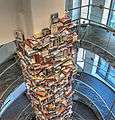Petersen House
|
Petersen House | |
 | |
 | |
| Location | 10th St., NW., between E and F Sts., Washington, D.C. |
|---|---|
| Coordinates | 38°53′48″N 77°1′33″W / 38.89667°N 77.02583°WCoordinates: 38°53′48″N 77°1′33″W / 38.89667°N 77.02583°W |
| Area | 0.29 acre (1200 m²) |
| Built | 1849 |
| Architectural style | Late Victorian |
| Visitation | 856,079 (2005) |
| Part of | Ford's Theatre National Historic Site (#66000034[1]) |
| Significant dates | |
| Designated CP | October 15, 1966 |
| Designated NHS | February 12, 2017 |
The Petersen House is a 19th-century federal style row house located at 516 10th Street NW in Washington, D.C. On April 15, 1865, United States President Abraham Lincoln died there after being shot the previous evening at Ford's Theatre located across the street. The house was built in 1849 by William A. Petersen, a German tailor. Future Vice-President John C. Breckinridge, a friend of the Lincoln family, once rented this house in 1852.[2] In 1865, it served as a boarding house. It has served as a museum since the 1930s.
Lincoln assassination
On the night of April 14, 1865, Lincoln and his wife Mary Todd were attending a performance of Our American Cousin when John Wilkes Booth, an actor and Southern sympathizer, entered the box and shot the President in the back of the head. Henry Rathbone and Clara Harris were also in the box with the Lincolns, and Rathbone suffered serious stab wounds while trying to prevent Booth's escape. Doctors including Charles Leale and Charles Sabin Taft examined Lincoln in the box before having him carried across the street to the Petersen House, where boarder Henry Safford directed them inside.[3]
Almarin Cooley Richards, superintendent of the Washington Metropolitan Police, was attending the performance and immediately began investigations. From the back parlor of the house, Richards interviewed witnesses and ordered the arrest of Booth.[4]
Physicians continually removed blood clots which formed over the wound and poured out the excess brain fluid and brain matter from where the bullet had entered Lincoln's head in order to relieve pressure on the brain. However, the external and internal hemorrhaging continued throughout the night.
During the night and early morning, guards patrolled outside to prevent onlookers from coming inside the house. Lincoln's Cabinet members, Generals, and various members of Congress were allowed to see the President.
Lincoln died in the house on April 15, 1865, at 7:22 a.m., aged 56.[5] Booth was located in Maryland 11 days later and was shot by Union forces, dying two hours later. Individuals in the room when he died included his son Robert Todd Lincoln, Senator Charles Sumner, generals Henry Wager Halleck, Richard James Oglesby and Montgomery C. Meigs, and Secretary of War Edwin Stanton.
Today
Since 1933, the National Park Service has maintained it as a historical museum, recreating the scene at the time of Lincoln's death. The bed that Lincoln occupied and other items from the bedroom had been bought by Chicago collector, Charles F. Gunther, and are now owned by and on display at the Chicago History Museum.[6][7] However, replicas have taken their places.[8] The bloodstained pillow and pillowcases are the ones used by Lincoln.[9][10]
Today, the Petersen House is administered by the National Park Service as part of the Ford's Theatre National Historic Site. Usually the house is open to visitors daily from 9:00 a.m. to 5:00 p.m.[11] Admission is free, but requires a time ticket.[3]
Images
 Modern recreation of the bedroom
Modern recreation of the bedroom Lincoln on his deathbed
Lincoln on his deathbed Petersen House circa 1918
Petersen House circa 1918 Front parlor
Front parlor Lincoln Book Tower
Lincoln Book Tower
References
- ↑ National Park Service (2009-03-13). "National Register Information System". National Register of Historic Places. National Park Service.
- ↑ Davis, William C. (2010). Breckinridge: Statesman, Soldier, Symbol. Lexington, Kentucky: The University Press of Kentucky. pp. 74, 513–514. ISBN 0807100684.
- 1 2 http://www.fordstheatre.org/home/performances-events/tours/petersen-house
- ↑ http://www.thespectrum.com/article/20090210/LIFESTYLE/902100325
- ↑ http://www.mrlincolnswhitehouse.org/inside.asp?ID=635&subjectID=4
- ↑ Ted Knutson. "Believe it or not, museum collections tell a story". Chicago Tribune. July 27, 1984. LF16.
- ↑ http://lincolnat200.org/exhibits/show/nowhebelongs/tyrannis/deathbed
- ↑ http://www.frommers.com/destinations/washingtondc/A21266.html
- ↑ Brown, David. "Is Lincoln Earliest Recorded Case of Rare Disease?". The Washington Post. Retrieved May 22, 2010.
- ↑ http://www.mytravelguide.com/attractions/profile-78238805-United_States_District_of_Columbia_Washington_Petersen_House.html
- ↑ http://www.nps.gov/foth
| Wikimedia Commons has media related to Petersen House. |